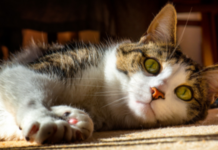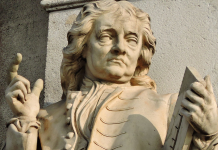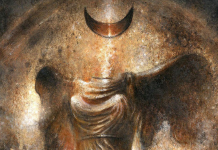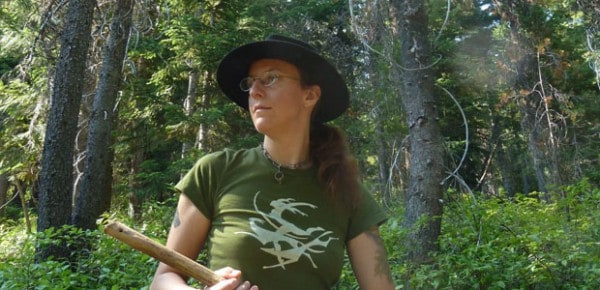
Lupa is an author, artist and nature-lover living in Portland, Oregon. Her most recent books are New Paths to Animal Totems: Three Alternative Approaches to Creating Your Own Totemism, and Plant and Fungus Totems: Connect with Spirits of Field, Forest, and Garden.
Lupa has been making art out of hide and bone for nearly 20 years, and her latest project is The Tarot of Bones: A Natural History Divination Set, currently being funded through Indiegogo through to May 19, 2015.
Psyche: First of all, congratulations on having your Indigogo campaign funded within your first 100 hours, that’s wonderful! It’s an unusual deck, and I wanted to know why tarot, why bones?
Lupa: Back in October [2014] I had a piece in a local gallery that had a group show with a tarot theme. It was my usual assemblage style, it had a coyote skull and some other things, basically pointing toward the Five of Coins. Putting the piece together, enjoying the show and being able to see everyone else’s interpretation of the tarot and their works, by the end of the evening I felt really inspired.
I thought about it for a while, and I decided to go ahead and do a full deck. Partly because I really like the symbolism of the various cards of the tarot – there are a lot of rich archetypes in there, a lot of just a lot of very relatable experiences in the cards — but also because I’ve been doing totemic work for the better part of 20 years, and there’s a lot of deep symbolism in that work as well. I wanted to combine this fairly human-centred symbolism of the tarot with a broader interpretation of nature.
Because I do the hide and bone work in my art, it just was natural (no pun intended) to centre it on bones. They’re very durable. They’re very visually appealing. They take to a number of different media nicely: you can paint them, you can glue things to them, and you can carve them. They make a really nice basis for a larger artistic project.
Has tarot been something that’s been part of your practice for a while, or was it a recent inspiration? How did that come about?
For me, it’s coming back to it. Back when I was a newbie Pagan, way way back in the day, I kinda went through that phase that a lot of newcomers do, with the whole, Well, I want to do herbalism, and I want to do tarot, and I want to stones, and I want to do this, and I want to do that, and I want to do everything! I was buying books on all of the Pagan-flavoured topics.
The first two divination system that I really picked up on were the Norse runes, the elder futhark, and the tarot. I spent a few years reading both of them at different times and for different reasons. Getting to know the symbolism pretty well, and really enjoying the comparison, the contrast.
I discovered in 1999 the Ted Andrew’s Animal Wise deck. It’s a tarot deck, it’s animal based, but I ended up working out a different layout. I got away from the tarot-based symbolism, but it never really went away.
I’ve always enjoyed the stories within the tarot and its ability to speak to our experiences, not just as individuals, but as a collective people. Everybody has, for example, those sleepless nights where we’re up with worry. We all have those moments of utter triumph, when we’ve put in a whole bunch of time and what we do comes to fruition. We’ve all had that. This is me coming back, not as a teenager, but as a 30-something who’s been through a lot more and I think the tarot speaks to me more now because I’ve had more life experience, and it’s been a really nice reunion.
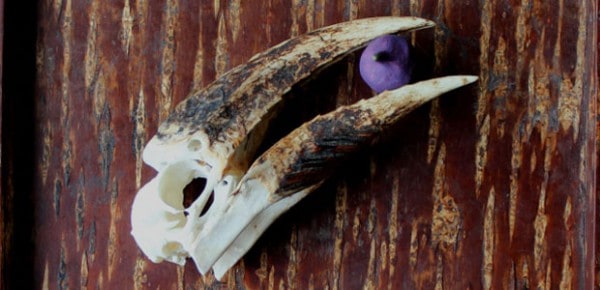
In your subtitle for the deck, you call it “A Natural History Divination Set,” and I was wondering, do you still see it as tarot-specifically, another kind of divination set, or a kind of hybrid?
It is very heavily tarot-based and I do take a fair amount of inspiration from the Rider-Waite-Smith deck as a lot of designers do — it’s my first tarot deck, and you can’t go wrong with the classics — but I do also draw a lot from natural history.
For example, one of my favourite cards in the major arcana is The Hermit. The animal I chose for that was a female hornbill, and I chose her because there are several species that nest in trees. They wall themselves in a crevice high up in a tree, so there’s only a little hole in the wall that they’ve made for food, and they sit in there for the entire time that they’re laying, incubating and hatching their eggs. She’s in there for weeks. She loses all of her flight feathers, she moults every feather that would help her escape otherwise, and other than the male coming to pass a little bit of food through, she’s in there by herself.
When she comes out, not only does she have a shiny new set of feathers that she’s grown, but she also has the brand new next generation of hornbills, and that spoke to me of the Hermit’s productive isolation. He’s not being anti-social, he’s not putting himself through hardships because he hates himself: he’s doing to get something better out of the experience. That’s one instance in which I really look to the natural world for inspiration, not just for what we humans get out of, but seeing our experiences mirror those of other animals.
It’s interesting that it’s so specific as well, it’s not just a bird skull; it’s this particular bird, for these particular reasons, and this is why it’s important. It sounds like your companion book will be essential to interpreting and understanding these cards. You wouldn’t really be able to purchase and work with it unless you were already a natural historian.
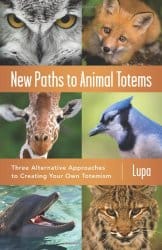 You could, but you’d get a lot more if you had the book.
You could, but you’d get a lot more if you had the book.
In writing the book, each of the major arcana and the court card have a very specific species of animal associated with them. The pips are just different types of bones. I assume that people already have a basic understanding of tarot. If they don’t, I say, Hey, go back to my bibliography, there are a few books you can pick up there. We’re not going to go over the basics.
There’s a brief introduction, a brief section on how to use this deck, and then the entry for each card. It has a brief description of the card, and then it has a section called My Inspiration, and it’s not: this card means this, this card means that. It’s, When this card comes up for me in a reading, this is what I get out of it, this is why I chose this particular animal or this configuration of bones. It’s the story behind each card. It’s very personal. You could definitely draw some interpretive information from what I write there, but just like my totemic work, I’m not at all dogmatic about it.
Which speaks to the tarot as well, because in all good readings, it’s a method of storytelling, it’s a way of drawing these things together, building a picture of what’s happening, and what you can do. Drawing from your inspiration for each card will be a very interesting experience for people who play with your deck.
Yeah, that’s what I’m hoping.
It definitely sounds that way, it’s amazing. In what other ways will the Tarot of Bones be different from other decks?
Most tarot decks are very anthropocentric, concerned with our human thoughts and biases and such. This set, conversely, invites us to come back to being a part of the rest of nature. Not just in the sense of “What can I get from nature?” but “How do I be responsible toward nature?”
Absolutely. How does deck answer that? Or will the book address that in the bit about your inspiration for the assemblages you create?
Some of it is explicitly stated in the intro and how to portions of the book. But there’s also the more subtle invitation to think like other animal species. Like the Hermit and the hornbill. What’s it like for a hornbill to be shut up in that tree for weeks? How does that relate to our own experiences? And so forth.
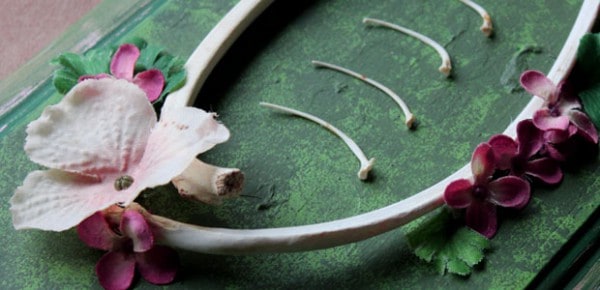
The structure of the deck seems really interesting, because you have different teeth and bones and different elements that go into constructing the trumps, the court cards, the pips. I was hoping you could talk about how that came about.
When I did that initial Five of Coins piece for the show, I just did a coyote skull with five blighted ears of wheat and that was the centre of that piece. It was a general, standalone artwork. The structure that I wanted to come up with for this deck took some more planning.
For your pips, each suit has a different type of bone associated with it. The swords are teeth, or jaws in the case of animals that don’t have teeth, like turtles and so forth. The teeth are there because not only can they bite, slash — they can also carefully nibble, they can snip. They can do very delicate things. They can even groom. They’re very precise in their actions.
The cups are ribs, and that’s not only because of their shape, but their function. They’re protecting some of the most delicate and vulnerable parts of the body, including the heart, and of course cups have that very deep emotional connection.
The wands are long bones. They’re leg and foot bones, and that’s because of the wands’ energy and movement and action. The legs are what move the animals around.
Probably my favourite was the pentacles, and for those I chose vertebrae. The reason isn’t just because they’re sort of spiky and have points, kind of like a pentacle does, but because the vertebrae is, of course, the backbone of the animal. It’s the part that the rest of the animal is hung on. It’s the first part of the vertebrate skeletal system to evolve millions of years ago. Look at the pentacles, if you don’t have the resources, the physical resources that you need just to stay alive, you can’t do much of anything else. You can’t go anywhere, you can’t really attend to more than very basic emotional stuff. You need the coins as a foundation to be able to work the rest of the information in a lot of ways. The coins are the backbone of a person’s everyday life.
So that’s your suits, and so your pips are just one through 10 of each of this type of bone.
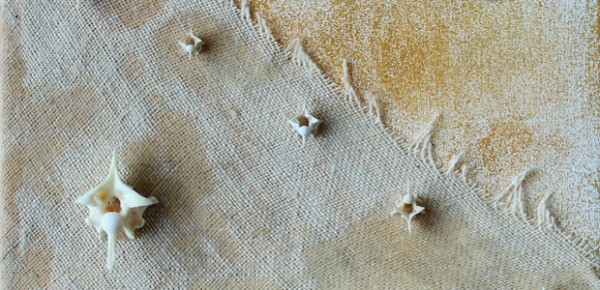
I just got done with the eight of swords, and that’s eight coyote teeth embedded in a mountain passageway, a very narrow mountain passage. I sculpted the sides of the pass in epoxy putty, painted them, and the teeth are embedded in that epoxy, in those mountain walls, to show this is a treacherous way. There’s a way through, if you’re very careful, but you have to know where to look, and you have to pay attention, as opposed to just letting yourself be blinded by past influences. You need to be looking ahead rather than back. That’s one example of how I put that together and that again especially with the pips. I’m taking a lot of inspiration from the Rider-Waite-Smith, because I didn’t just want to have,you know, six ribs, one stacked one on top of the other. That’s kind of boring. I want there to be a story.
For your court cards, I chose a different species of animal for each one. For each of the court cards there’s the upper part of the skull, no jaw, with the exception of a couple of the swords.
For example the Knight of Swords is a snapping turtle. Not the fastest moving animal in most circumstances, but when he wants to make something happen, he can move very quickly. That reminded me very much of the brashness and boldness of the Knight of Swords, and it’s actually a skull that’s got a little bit of damage, and it reminds me very much of how the Knight of Swords can sometimes be detrimental to himself in his actions.
He does have this jaw, but it’s detached from the rest of the skull, it’s sitting below it, and most of the court cards will have the upper part of the skull and then a second bone that signifies its suit. So, the Knight of Wands is a turkey, and there’s the upper part of a turkey skull, and there’s a wing bone below it.
Your majors all have complete skulls. Jaw and everything, and that’s to show that they have more power than the courts. It’s that sort of graduated system from just bones, to partial skull, to full skull. Of course, in the book I go through that and explain a little more about it, but that’s the gist of it.
That sounds very well thought out, well planned and articulated. Some of the images look like they’re landscape and some of them look like they’re portrait, how is that determined?
Well, they’re eventually all going to be portrait. They’re all going to be photographed on backdrops, so the ones that currently look landscape have a good field above and below them. I’m working with second hand materials for the backboards — everything from old cutting boards to picture frames, TV trays — whatever I happen to find that works. Sometimes the layout of the piece wants to be portrait, and sometimes it wants to be landscape. When I do the final photos everything will be cropped so that it is portrait oriented.
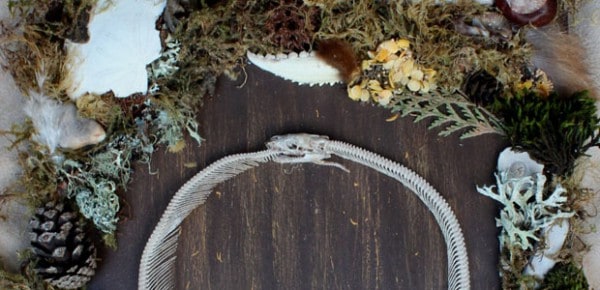
How do you come by the materials? Are they found, killed, bought?
All of the above.
Nothing was killed just for my artwork, I want to make that very clear. I do get people saying, “Is it all natural deaths?” No, it’s not. That’s the truth about things. You get some people who are selling hides and bones, and they say it’s all from natural death, and then they have something that very clearly came from a fur farm. That’s very frustrating.
The truth is that a) most animals that die in nature are going to very quickly become food for something else, b) you’re kinda limited by species. There are no hornbills in the US outside of zoos, so I can’t just walk out and pick up a hornbill skull or a hyena skull or anything else like that. I’ve had to go through several different of my providers of various dead things.
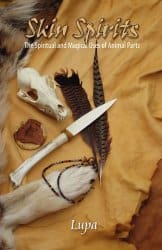 I’ve been doing this for the better part of two decades. I’ve been able to vet my suppliers very well. There are a few that I trust very deeply to not be supporting poaching, to do everything legally, and I also have done my own research over the years in making sure that what I have is not only legal, but is also sustainable. There are certain species that are technically legal to trade in, but I don’t feel comfortable having their remains, because of the amount of hunting that’s being done. It’s usually species that aren’t as well studied, but that’s a whole big rant. The short version is that I’m very careful about where these things come from. Most of it is bought. The skulls and bones are generally bought from suppliers.
I’ve been doing this for the better part of two decades. I’ve been able to vet my suppliers very well. There are a few that I trust very deeply to not be supporting poaching, to do everything legally, and I also have done my own research over the years in making sure that what I have is not only legal, but is also sustainable. There are certain species that are technically legal to trade in, but I don’t feel comfortable having their remains, because of the amount of hunting that’s being done. It’s usually species that aren’t as well studied, but that’s a whole big rant. The short version is that I’m very careful about where these things come from. Most of it is bought. The skulls and bones are generally bought from suppliers.
There are a few things that were found, like a lot of the deer bones are ones that I’ve found over the years. I do also in a few cases use resin replicas of skulls. There are a few species that were absolutely perfect for a particular card but I can’t legally have their parts.
For Temperance I chose the burrowing owl because they’re active both during the day, and at night. Rather than living in trees, they live underground, and they’re as likely to chase after their prey by running after it on the ground as they are to fly after it. You have this animal that is both comfortable on the land and on the air, and that is both diurnal and nocturnal, and that really spoke to me of that balancing element of Temperance. But you can’t have burrowing owl parts in the US, so I got a resin replica from a friend of mine who is an artist who specializes in making these replicas.
That being said, I don’t really like using resin if I don’t have to because it’s a plastic. Plastic is petroleum-based, it doesn’t biodegrade, there are a lot of pollutants that come out of its manufacture, and that’s why I generally prefer using real bone, because eventually it’s going to fall apart into calcium and go back to the earth.
What happens to these assemblage pieces once they’re all photographed? Are they going to go into a gallery?
The deck and book are out in the summer of 2016. I’ve been in contact with several galleries about showing some of the pieces through the latter half of 2016 to let people see them in person, and to use as a promotional opportunity for the Tarot of Bones. People do have the option in the Indiegogo campaign to pre-order one of the pieces if they so choose. That being said, the pieces won’t be delivered until early 2017, so that I still have the opportunity to show them.
My absolute grail goal, as it were, is to show all 79 pieces in one spot, but I don’t think that’s going to happen. It would take up a lot of room and I’m just not that famous an artist for someone to do a whole solo show in a fine art gallery. However, like I said, I figure I can get a good number of them on display in multiple galleries and get good feedback and exposure for them.
Once early 2017 comes around, I’m going to start shipping the ones that are already sold out, then I’ll put the rest up online for sale, probably on the Tarot of Bones website, and we’ll see what goes there.
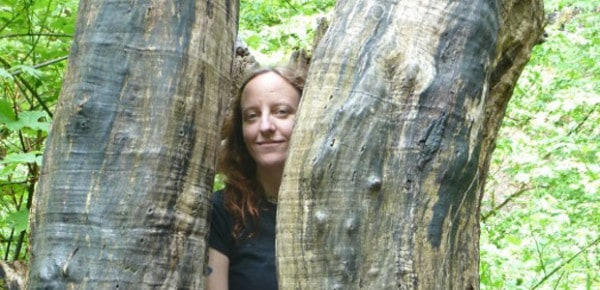
You have a Patreon fund at the moment, which seems quite successful. Why Indiegogo for this project?
Patreon and Indiegogo work very different in certain respects. They’re both really good crowdfunding platforms, but Patreon is on a month-by-month basis, and so it’s a continuous patronage. I have some people who are subscribed to my artwork packages on Patreon, and every month, depending on how much they’re giving me, I send them a box of art, and that’s an ongoing basis. Patreon is for my books, my artwork, my other writing, etc. It’s sort of a general, “Hey let’s support Lupa” thing.
The Indiegogo lets people get very specific about the Tarot of Bones, it’s also a time-limited form of crowdfunding. So, there’s a definite beginning, middle and end, and that gives people more structure. There’s a certain urgency to an Indiegogo — you know that there’s a particular point by which you have to give, and that works for both the person giving and for the artist who’s getting the money. It works for the person giving because it gives them a deadline to work with because otherwise they could go, “Oh, I’ll do it tomorrow,” and I think we’ve all had those campaigns where we’ve really wanted to give, we’re just waiting for the next paycheque, and by the time the next paycheque showed up the campaign was done. So it keeps us on our toes.
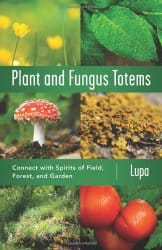 But on my end, it helps me stay on my deadlines. I know that by the campaign through May 19th, and I think I get the money 15 days after that — after everything has been processed, and any declined cards have been cut out of the system, etc. That means by early June I’m going to have a big chunk of money that I can then depend on to buy the rest of my materials for the rest of these assemblage pieces, which was the main reason for this Indiegogo campaign. All the other money is going to get tucked away for other to put towards other expenses like printing, shipping, fulfilling perks, and so forth.
But on my end, it helps me stay on my deadlines. I know that by the campaign through May 19th, and I think I get the money 15 days after that — after everything has been processed, and any declined cards have been cut out of the system, etc. That means by early June I’m going to have a big chunk of money that I can then depend on to buy the rest of my materials for the rest of these assemblage pieces, which was the main reason for this Indiegogo campaign. All the other money is going to get tucked away for other to put towards other expenses like printing, shipping, fulfilling perks, and so forth.
If I were to just do a general, “Hey, give me some money for this thing that I’m doing,” who knows when it would show up? This lets me have a little more controlled idea of when the money is going to show up that lets me do some planning, because I’m keeping myself on a pretty tight schedule too. My goal is to have all the assemblage pieces done by the end of the year. I’m actually a little bit ahead of schedule at this point, and I’m going to try to push myself to stay ahead of schedule.
I want to have the book and deck out the summer of 2016. In order to be able to do that, I need to have certain levels of funding already achieved, so I can buy the materials, pay for the printing costs, pay for other associated costs, get the book edited, things like that. The Indiegogo works really well because it says, “Ok, here is the magical time at which you can throw money at me, and I can use it to make this thing happen.” That being said, I have had some of my Patreon patrons also donate to the Indiegogo campaign, which has been absolutely awesome, and I’m really grateful to them for that double level of support there.
Your stretch goal for the Happy Squirrel card has already been achieved, what else is in store for Indiegogo supporters?
To be honest, when I started the campaign I wasn’t expecting to get it fully funded, so I wasn’t prepared with stretch goals. I had to come up with them pretty quickly when it became apparent that the campaign would be fully funded in under a week.
I admit, I really wanted to do a Happy Squirrel card just because it’s a wonderfully silly creation. I remember seeing that episode of the Simpsons when it first aired, and it’s a perfect addition to an animal-based tarot set. Plus I didn’t have a good squirrel in the deck already. I mean, I have a Columbian ground squirrel coming up in one of the court cards, but not a tree squirrel. So we unlocked the Happy Squirrel when we hit $7,000.
Next one is $9,000. When we get to that, I’ll be offering an exclusive Livestream class on the Tarot of Bones for Indiegogo backers. Those backers who can’t make it to the Livestream will have the video emailed to them, and I’ll wait a month before putting it up on YouTube for general perusal. We’re just a little over $1,000 away from that, by the way.
And then, if get to $12,000, I’ll be producing an audiobook version of the Tarot of Bones book. But that’s quite a long way away.
You’ve got a little over 20 days, it could easily happen.
True. The new backers dropped off a lot once we hit $5,000, and yesterday was the first day that I had no new backers at all. But there’s usually another big rush of people near the end of most crowdfunding campaigns, so I’m hopeful. I mean, even if I don’t make any more than I have, I’m already incredibly grateful. The amount of support has been overwhelming.
Check out Lupa’s website for the Tarot of Bones, the Indiegogo campaign, her Etsy shop for other dead things. You can also support Lupa on Patreon.


